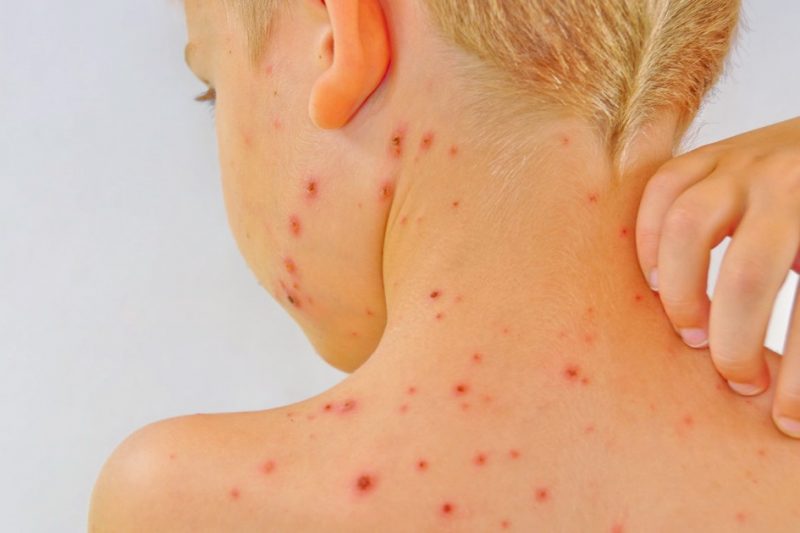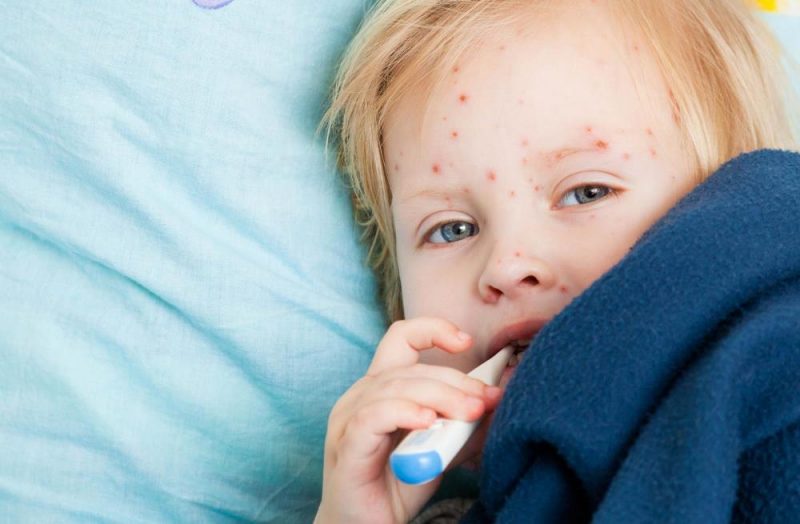Chickenpox is caused by the herpes virus - the same that causes shingles. The disease is quite “volatile”, therefore, in preschool and school institutions, quarantine is often imposed if someone finds such an ailment. How chickenpox is transmitted is the topic of our article today.
Material Content:
How many days is chickenpox contagious during the incubation period

Chickenpox includes several stages:
- incubation;
- premonitory;
- rash period;
- final.
The incubation period can also be divided into several stages:
- Initial. At this stage, the person becomes infected with the virus. It enters the body and is firmly fixed to the mucous membranes. Since that time, immunity can no longer cope with the virus. The initial stage can last from 1 to 7 days. The patient in this period does not suspect about the state of his health, he is not contagious.
- Developing. At this stage, the virus has already multiplied - it penetrates the respiratory organs, lymph nodes, and blood. A person is able to feel a slight malaise, there are no rashes on the body yet. The patient is still not contagious to others.
- The final one. We can say that the virus "walks" throughout the body. It accumulates in the epithelium, pimples begin to appear on the skin. 1-2 days before the first rash appears, the patient becomes contagious.
The incubation period lasts an average of 7 to 21 days. It all depends on human immunity.
The insidiousness of chickenpox lies in the fact that it is almost impossible to identify the disease before the rash appears (the exception is a detailed blood test).That is why in collectives the disease is massive. In 90% of cases, everyone who comes into contact with the diseased is infected.
Chicken pox virus transmission routes

You can get chickenpox in several ways:
- By airborne droplets. The most common. It is not necessary to have close contact with the patient, since the chickenpox virus is quite volatile. Therefore, if an infected person appears in your house on the 5th floor, the probability of catching a virus at the entrance to the building is 85%. For this reason, when a patient with chickenpox is detected in school and preschool institutions, they are quarantined. It lasts an average of 10 to 14 days. Children can visit the institution, but at the same time they are examined daily by a full-time nurse. Body temperature is measured, rooms are constantly ventilated, treated with disinfectants.
- Through saliva. Outbreaks of the disease are often reported in adolescents. They transmit the virus to each other through kisses.
- Intrauterine. If the expectant mother during pregnancy has chickenpox, the doctor carefully monitors the condition of the fetus. In the 1st trimester, when the baby is laying all the internal organs, the virus can cause serious abnormalities in the development of crumbs. In this case, they offer additional examinations (ultrasound, blood screening). In the second and third trimester, the placenta ages, becomes thinner, the virus is able to freely reach the fetus. In these cases, the baby may be born with skin rashes.
- Contact. During the disease, the papules are filled with fluid. It can get on the skin of a healthy person. If there is a violation of the integrity of the epithelium, the probability of infection is more than 60%.
The chickenpox carrier, before the appearance of rashes on the body, does not even suspect that it is dangerous to others.
The first symptoms of the development of the disease
Chickenpox does not begin with rashes.
The first symptoms of the disease are as follows:
- Slight malaise. The patient wants to lie down, he tends to sleep, there is a breakdown.
- Runny nose. In this case, the snot is not thick. The excreted liquid is transparent, resembles water.
- Sore throat. A doctor during examination can observe swelling of the larynx and redness of the tonsils.
- Dry cough that does not stop even after taking expectorant drugs.
- Photophobia. Patients complain of pain in the eyes, the sun's rays cause them a sense of discomfort.
These symptoms are easily confused with a cold. They last from 1 to 3 days. At the same time, body temperature remains within normal limits.
Then there are rashes on the skin. At first, these are small single pink or red pimples. Outwardly, they are very similar to a mosquito bite.

Acne covers most of the body during the day. They can be located close to each other, merge into one large pimple.
Over time, the upper part of the epithelium disappears, the rash turns into vesicles filled with a clear liquid. Papules begin to itch and itch.
The main task is to rid the patient of such discomfort. This can be done with antihistamines and special medications (Tsindol, Psilo Balsam, Miramistin, Fenistil, Acyclovir, Calamine).
Gradually, the liquid comes out, a small wound is formed, covered with a crust. You cannot get rid of it on your own - scars will remain on the skin.
The wounds will come off completely within a few weeks.
When a virus ceases to be contagious
A person ceases to be contagious 5 days after the last rash. It is for this that many “mark” pimples with green paint. It’s easier to understand which ones are new. For these purposes, you can use Fukortsin.
Recently, doctors increasingly agree that Fukortsin and Zelenka should be replaced with other drugs that not only dry pimples, but also relieve itching and inflammation.
How chickenpox is transmitted through third parties
Is chickenpox transmitted through third parties? This question is still a subject of heated debate among many experts.
And that's why:
- firstly, the virus dies very quickly in the environment;
- secondly, increased humidity, low air temperature, ultraviolet rays are harmful to the virus;
- thirdly, so far it has not been possible to register a single case of infection with an ailment through household items.
From this we can conclude that the chickenpox virus is transmitted only from an infected person to a healthy person.
Methods to prevent chickenpox
Is there any possibility of preventing chickenpox? Doctors say that the only way not to get infected is to get vaccinated. In most countries, such vaccination is mandatory.
Children under 13 years of age are recommended 1 dose of the drug. The introduced agent develops a stable immunity to the disease in the child.
Adolescents and adults need a double vaccination. In this case, the immunity to the virus is 99%.
All medicines from chickenpox are of foreign manufacture.
Among them are:
- Varilrix. It can be used within 3 days after contact with the patient. The vaccine contains an attenuated chickenpox virus.
- Okavax. The drug is available in France. Complications after its introduction in most cases are absent.
Who should be vaccinated with:
- children with weakened immunities;
- women planning a pregnancy (previously not suffering from chickenpox);
- adults who in childhood were not infected with the virus.
Chickenpox spreads rapidly throughout the room. The virus is volatile, therefore it is not surprising that when a child falls ill in the garden, the disease covers all groups of the preschool institution.
Do not treat chickenpox as a mild illness. It can cause serious complications and even lead to death. Therefore, at the first signs of infection, you must immediately consult a doctor to get the required treatment.












